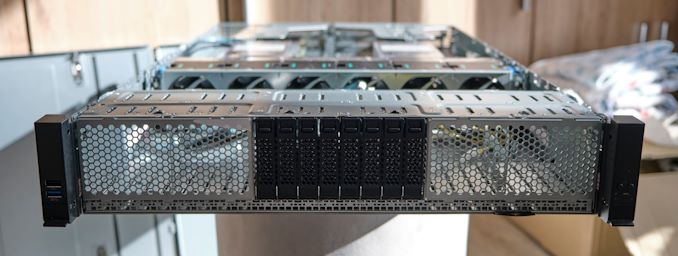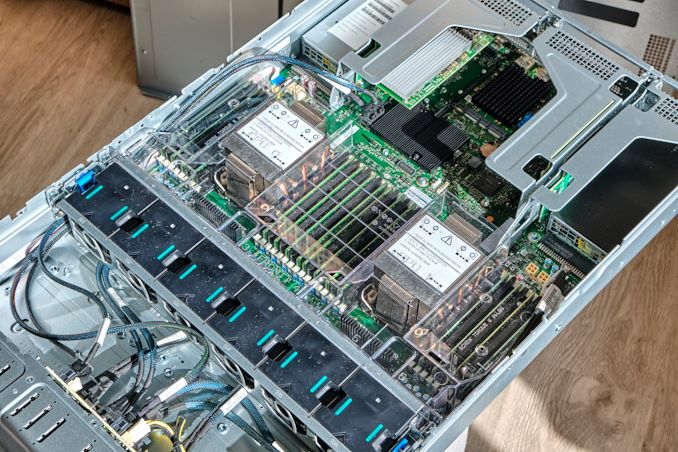Intel 3rd Gen Xeon Scalable (Ice Lake SP) Review: Generationally Big, Competitively Small
by Andrei Frumusanu on April 6, 2021 11:00 AM EST- Posted in
- Servers
- CPUs
- Intel
- Xeon
- Enterprise
- Xeon Scalable
- Ice Lake-SP
Test Bed and Setup - Compiler Options
For the rest of our performance testing, we’re disclosing the details of the various test setups:
Intel - Dual Xeon Platinum 8380
For our new Ice Lake test system based on the Whiskey Lake platform, we’re using Intel’s SDP (Software Development Platform 2SW3SIL4Q, featuring a 2-socket Intel server board (Coyote Pass).
The system is an airflow optimised 2U rack unit with otherwise little fanfare.
Our review setup solely includes the new Intel Xeon 8380 with 40 cores, 2.3GHz base clock, 3.0GHz all-core boost, and 3.4GHz peak single core boost. That’s unusual about this part as noted in the intro, it’s running at a default 205W TDP which is above what we’ve seen from previous generation non-specialised Intel SKUs.
| CPU | 2x Intel Xeon Platinum 8380 (2.3-3.4 GHz, 40c, 60MB L3, 270W) |
| RAM | 512 GB (16x32 GB) SK Hynix DDR4-3200 |
| Internal Disks | Intel SSD P5510 7.68TB |
| Motherboard | Intel Coyote Pass (Server System S2W3SIL4Q) |
| PSU | 2x Platinum 2100W |
The system came with several SSDs including Optane SSD P5800X’s, however we ran our test suite on the P5510 – not that we’re I/O affected in our current benchmarks anyhow.
As per Intel guidance, we’re using the latest BIOS available with the 270 release microcode update.
Intel - Dual Xeon Platinum 8280
For the older Cascade Lake Intel system we’re also using a test-bench setup with the same SSD and OS image as on the EPYC 7742 system.
Because the Xeons only have 6-channel memory, their maximum capacity is limited to 384GB of the same Micron memory, running at a default 2933MHz to remain in-spec with the processor’s capabilities.
| CPU | 2x Intel Xeon Platinum 8280 (2.7-4.0 GHz, 28c, 38.5MB L3, 205W) |
| RAM | 384 GB (12x32 GB) Micron DDR4-3200 (Running at 2933MHz) |
| Internal Disks | Crucial MX300 1TB |
| Motherboard | ASRock EP2C621D12 WS |
| PSU | EVGA 1600 T2 (1600W) |
The Xeon system was similarly run on BIOS defaults on an ASRock EP2C621D12 WS with the latest firmware available.
AMD - Dual EPYC 7763 / 7713 / 75F3 / 7662
In terms of testing the new EPYC 7003 series CPUs, unfortunately due to our malfunctioning Daytona server, we weren’t able to get first-hand experience with the hardware. AMD graciously gave us remote access to one of their server clusters – we had full controls of the system in terms of BMC as well as BIOS settings.
| CPU | 2x AMD EPYC 7763 (2.45-3.500 GHz, 64c, 256 MB L3, 280W) / 2x AMD EPYC 7713 (2.00-3.365 GHz, 64c, 256 MB L3, 225W) / 2x AMD EPYC 75F3 (3.20-4.000 GHz, 32c, 256 MB L3, 280W) / 2x AMD EPYC 7662 (2.00-3.300 GHz, 64c, 256 MB L3, 225W) |
| RAM | 512 GB (16x32 GB) Micron DDR4-3200 |
| Internal Disks | Varying |
| Motherboard | Daytona reference board: S5BQ |
| PSU | PWS-1200 |
Software wise, we ran Ubuntu 20.10 images with the latest release 5.11 Linux kernel. Performance settings both on the OS as well on the BIOS were left to default settings, including such things as a regular Schedutil based frequency governor and the CPUs running performance determinism mode at their respective default TDPs unless otherwise indicated.
AMD - Dual EPYC 7742
Our local AMD EPYC 7742 system, due to the aforementioned issues with the Daytona hardware, is running on a SuperMicro H11DSI Rev 2.0.
| CPU | 2x AMD EPYC 7742 (2.25-3.4 GHz, 64c, 256 MB L3, 225W) |
| RAM | 512 GB (16x32 GB) Micron DDR4-3200 |
| Internal Disks | Crucial MX300 1TB |
| Motherboard | SuperMicro H11DSI0 |
| PSU | EVGA 1600 T2 (1600W) |
As an operating system we’re using Ubuntu 20.10 with no further optimisations. In terms of BIOS settings we’re using complete defaults, including retaining the default 225W TDP of the EPYC 7742’s, as well as leaving further CPU configurables to auto, except of NPS settings where it’s we explicitly state the configuration in the results.
The system has all relevant security mitigations activated against speculative store bypass and Spectre variants.
Ampere "Mount Jade" - Dual Altra Q80-33
The Ampere Altra system we’re using the provided Mount Jade server as configured by Ampere. The system features 2 Altra Q80-33 processors within the Mount Jade DVT motherboard from Ampere.
In terms of memory, we’re using the bundled 16 DIMMs of 32GB of Samsung DDR4-3200 for a total of 512GB, 256GB per socket.
| CPU | 2x Ampere Altra Q80-33 (3.3 GHz, 80c, 32 MB L3, 250W) |
| RAM | 512 GB (16x32 GB) Samsung DDR4-3200 |
| Internal Disks | Samsung MZ-QLB960NE 960GB Samsung MZ-1LB960NE 960GB |
| Motherboard | Mount Jade DVT Reference Motherboard |
| PSU | 2000W (94%) |
The system came preinstalled with CentOS 8 and we continued usage of that OS. It’s to be noted that the server is naturally Arm SBSA compatible and thus you can run any kind of Linux distribution on it.
The only other note to make of the system is that the OS is running with 64KB pages rather than the usual 4KB pages – this either can be seen as a testing discrepancy or an advantage on the part of the Arm system given that the next page size step for x86 systems is 2MB – which isn’t feasible for general use-case testing and something deployments would have to decide to explicitly enable.
The system has all relevant security mitigations activated, including SSBS (Speculative Store Bypass Safe) against Spectre variants.
The system has all relevant security mitigations activated against the various vulnerabilities.
Compiler Setup
For compiled tests, we’re using the release version of GCC 10.2. The toolchain was compiled from scratch on both the x86 systems as well as the Altra system. We’re using shared binaries with the system’s libc libraries.












169 Comments
View All Comments
Oxford Guy - Wednesday, April 7, 2021 - link
You're arguing apples (latency) and oranges (capability).An Apple II has better latency than an Apple Lisa, even though the latter is vastly more powerful in most respects. The sluggishness of the UI was one of the big problems with that system from a consumer point of view. Many self-described power users equated a snappy interface with capability, so they believed their CLI machines (like the IBM PC) were a lot better.
GeoffreyA - Wednesday, April 7, 2021 - link
"today's software and OSes are absurdly slow, and in many cases desktop applications are slower in user-time than their late 1980s counterparts"Oh yes. One builds a computer nowadays and it's fast for a year. But then applications, being updated, grow sluggish over time. And it starts to feel like one's old computer again. So what exactly did we gain, I sometimes wonder. Take a simple suite like LibreOffice, which was never fast to begin with. I feel version 7 opens even slower than 6. Firefox was quite all right, but as of 85 or 86, when they introduced some new security feature, it seems to open a lot slower, at least on my computer. At any rate, I do appreciate all the free software.
ricebunny - Wednesday, April 7, 2021 - link
Well said.Frank_M - Thursday, April 8, 2021 - link
Intel Fortran is vastly faster then GCC.How did ricebunny get a free compiler?
mode_13h - Thursday, April 8, 2021 - link
> It's strange to tell people who use the Intel compiler that it's not used much in the real world, as though that carries some substantive point.To use the automotive analogy, it's as if a car is being reviewed using 100-octane fuel, even though most people can only get 93 or 91 octane (and many will just use the cheap 87 octane, anyhow).
The point of these reviews isn't to milk the most performance from the product that's theoretically possible, but rather to inform readers about how they're likely to experience it. THAT is why it's relevant that almost nobody uses ICC in practice.
And, in fact, BECAUSE so few people are using ICC, Intel puts a lot of work into GCC and LLVM.
GeoffreyA - Thursday, April 8, 2021 - link
I think that a common compiler like GCC should be used (like Andrei is doing), along with a generic x86-64 -march (in the case of Intel/AMD) and generic -mtune. The idea would be to get the CPUs on as equal a footing as possible, even with code that might not be optimal, and reveal relative rather than absolute performance.Wilco1 - Thursday, April 8, 2021 - link
Using generic (-march=x86-64) means you are building for ancient SSE2... If you want a common baseline then use something like -march=x86-64-v3. You'll then get people claiming that excluding AVX-512 is unfair eventhough there is little difference on most benchmarks except for higher power consumption ( https://www.phoronix.com/scan.php?page=article&... ).GeoffreyA - Saturday, April 10, 2021 - link
I think leaving AVX512 out is a good policy.GeoffreyA - Thursday, April 8, 2021 - link
If I may offer an analogy, I would say: the benchmark is like an exam in school but here we test time to finish the paper (and with the constraint of complete accuracy). Each pupil should be given the identical paper, and that's it.Using optimised binaries for different CPUs is a bit like knowing each child's brain beforehand (one has thicker circuitry in Bodman region 10, etc.) and giving each a paper with peculiar layout and formatting but same questions (in essence). Which system is better, who can say, but I'd go with the first.
Oxford Guy - Wednesday, April 7, 2021 - link
Well, whatever tricks were used made Blender faster with the ICC builds I tested — both on AMD's Piledriver and on several Intel releases (Lynnfield and Haswell).